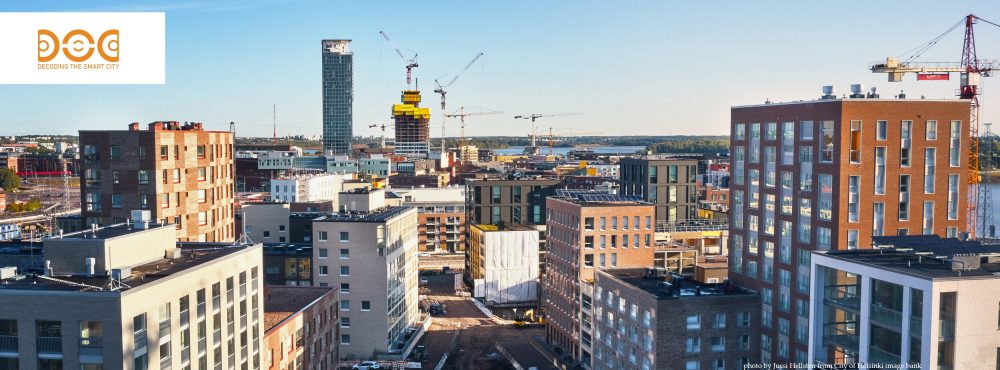Aims
1. Promote better design for smart cities by analysing the influence of technological solutions in social dynamics and everyday life
2. Increase discussion among researchers and practitioners about social impacts of smart city projects
3. Gather information and compare current methods of data collection and analysis used in smart city projects
4. Generate ideas on how to combine innovative methods of data collection and approaches to impact assessment to better understand short and long-term social impacts of smart city projects
Background
Investment in smart city initiatives and research is growing, presenting new opportunities to research their impacts. Development is seen across Nordic countries in projects such as Smart City Sweden, Open Data DK, and Select for Cities, an Internet of Things platform in Denmark. In Finland, the 6Aika strategy coordinates “smart and open” initiatives across the country’s six largest cities, reaching an estimated 30% of the country’s population (City of Helsinki et al., 2015). Smart city research in Finland will be further developed in the recently launched FINEST Twins project, a five-year, €32 million research collaboration between Helsinki and Tallinn, coordinated by a new Smart City Centre of Excellence based at TalTech in Estonia.
There is an abundance of data collected about how people live in urban settings – how they communicate, navigate, produce and consume. Some of this data has been used to inform or monitor smart city projects, but little has been done to assess if and how smart cities have changed behaviours and quality of life, though as Sharifi (2020) notes, increased quality of life is seen as a priority in smart city assessment tools, along with governance, economy and environment. While assessment schemes exist, as described by United for Smart Sustainable Cities (U4SSC) and the Lisbon Ranking for Smart Sustainable Cities (LRCS), indicators do not address short- and long-term social impacts (UN, 2017; Akande et al., 2019).
The operations of smart cities, especially consumption and movement, are well documented. Smart systems monitor resource use and environmental conditions, such as air and water quality, energy consumption and heating and cooling. Sensors, personal devices, payment and other systems allow governments and vendors to follow traffic patterns and understand how individuals and vehicles move, use public transit and bike share programs, parking and more. Other forms of surveillance trace personal activity and most recently, the spread of COVID-19. These systems have been useful in optimizing operations, but they have not looked closely at the motivations behind behaviours, and they raise concerns about inclusivity, privacy and personal freedoms.
New research methods are emerging that balance qualitative and quantitative data, employing human-centred approaches and innovative technologies with the potential to shed light on the social impacts of smart cities. For example, the SoftGIS system uses subjective and objective data to tie survey responses to specific locations, connecting living environments to topics such as happiness and child-friendliness (Kyttä and Kahila, 2011). Crowdsourcing platforms like Fix My Street facilitate communication between citizens and governments, while a smartphone game developed for bus riders in Mexico City maps the routes of the informal transit system (Cooke, 2018). Social networks and citizen-initiated content offer other insights into daily life, as seen with reports of inappropriate behaviours on the Smart Kalasatama Facebook page in Helsinki. Participatory urban-planning is taking on new forms, such as eye-tracking to understand what interests people when viewing plans (Vainio et al. 2019), or “eparticipation” using social media to identify intangible cultural heritage (Nummi, 2018).
These examples suggest that there are many ways to mix methods to achieve a more human-centred focus and to reflect the specific contexts in which the evaluation takes place. Furthermore, they raise questions about how social media and other platforms are being used to engage people in smart city development and how this impacts their experience of participation. Combining smart city technologies with approaches based in design research could lead to new understandings of behaviours, values, and quality of life.
References
- Akande, A., Cabral, P., Gomes, P., & Casteleyn, S. (2019). The Lisbon ranking for smart sustainable cities in Europe. Sustainable Cities and Society, 44, 475–487.
- Cooke, J. (2018, April 18). The Impossible Possible City. How Mexico City’s Urban Innovation Lab Tackles the City’s Challenges. Curbed.
https://www.curbed.com/2018/4/18/17233228/mexico-city-urban-planning-laboratorio-para-la-ciudad - Helsinki, Espoo, Vantaa, Tampere, Turku, & Oulu. (2015). The Six City Strategy – Open and Smart Services (p. 28). https://6aika.fi/wp-content/uploads/2015/11/6Aika-strategia_p%C3%A4ivitys_2015_EN.pdf
- Johnson, M., Hyysalo, S., Mäkinen, S., Helminen, P., Savolainen, K., and Hakkarainen, L. (2014). From recipes to meals… And dietary regimes: Method Mixes as key emerging topic in human-centered design. Proceedings of the 8th Nordic Conference on Human-Computer Interaction:Fast, Fun, Foundational, 343–352.
- Kyttä, M., and Kahila, M. (2011, February 21). SoftGIS Methodology. Building Bridges in Urban Planning. GIM International. https://www.gim-international.com/content/article/softgis-methodology
- Nummi, P. (2018). Crowdsourcing Local Knowledge with PPGIS and Social Media for Urban Planning to Reveal Intangible Cultural Heritage. Urban Planning, 3(1), 100–115.
- Sharifi, A. (2020). A typology of smart city assessment tools and indicator sets. Sustainable Cities and Society, 53, 101936.
- United Nations. (2017). United For Smart Sustainable Cities. Collection Methodology for Key Performance Indicators for Smart Sustainable Cities. https://www.itu.int/en/publications/Documents/tsb/2017-U4SSC-Collection-
Methodology/mobile/index.html#p=1 - Vainio, T., Karppi, I., Jokinen, A., and Leino, H. (2019). Towards Novel Urban Planning Methods – Using Eye-tracking Systems to Understand Human Attention in Urban Environments. In Extended Abstracts of the 2019 CHI Conference on Human Factors in Computing Systems (CHI EA ’19). Association for Computing Machinery, New York, NY, USA, Paper CS30, 1–8.

